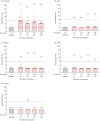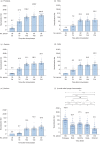The kinetics of IgG subclasses and contributions to neutralizing activity against SARS-CoV-2 wild-type strain and variants in healthy adults immunized with inactivated vaccine
- PMID: 35751471
- PMCID: PMC9349727
- DOI: 10.1111/imm.13531
The kinetics of IgG subclasses and contributions to neutralizing activity against SARS-CoV-2 wild-type strain and variants in healthy adults immunized with inactivated vaccine
Abstract
Neutralizing antibody is an important indicator of vaccine efficacy, of which IgG is the main component. IgG can be divided into four subclasses. Up to now, studies analysing the humoral response to SARS-CoV-2 vaccination have mostly focused on measuring total IgG, and the contribution of specific IgG subclasses remains elusive. The aim of this study is to investigate the kinetics of neutralizing antibodies and IgG subclasses, and to explore their relationships in people vaccinated with inactivated COVID-19 vaccine. We conducted a prospective cohort study in 174 healthy adults aged 18-59 years old who were administrated 2 doses of CoronaVac 14 days apart and a booster dose 1 year after the primary immunization, and followed up for 15 months. Blood samples were collected at various time points after primary and booster immunization. We used live SARS-CoV-2 virus neutralizing assay to determine neutralizing ability against the wild-type strain and 4 variants (Beta, Gamma, Delta and Omicron) and ELISA to quantify SARS-CoV-2 RBD-specific IgG subclasses. The results showed that the 2-dose primary immunization only achieved low neutralizing ability, while a booster shot can significantly enhance neutralizing ability against the wild-type strain, Beta, Gamma, Delta and Omicron variants. IgG1 and IgG3 were the most abundant serum antibodies, and IgG2 and IgG4 were hardly detected at any time. The ratio of IgG1/IgG3 was positively associated with the neutralization ability. The underlying mechanism requires further exploration.
Keywords: IgG subclasses; SARS-CoV-2 inactivated vaccine; neutralization ability; variants.
© 2022 The Authors. Immunology published by John Wiley & Sons Ltd.
Conflict of interest statement
The authors declare no conflict of interest.
Figures







Similar articles
-
Generation of neutralizing antibodies against Omicron, Gamma and Delta SARS-CoV-2 variants following CoronaVac vaccination.Rev Inst Med Trop Sao Paulo. 2022 Feb 25;64:e19. doi: 10.1590/S1678-9946202264019. eCollection 2022. Rev Inst Med Trop Sao Paulo. 2022. PMID: 35239863 Free PMC article.
-
A Booster Dose of CoronaVac Increases Neutralizing Antibodies and T Cells that Recognize Delta and Omicron Variants of Concern.mBio. 2022 Aug 30;13(4):e0142322. doi: 10.1128/mbio.01423-22. Epub 2022 Aug 10. mBio. 2022. PMID: 35946814 Free PMC article.
-
Long-Term Kinetics of SARS-CoV-2 Antibodies and Impact of Inactivated Vaccine on SARS-CoV-2 Antibodies Based on a COVID-19 Patients Cohort.Front Immunol. 2022 Jan 27;13:829665. doi: 10.3389/fimmu.2022.829665. eCollection 2022. Front Immunol. 2022. PMID: 35154152 Free PMC article.
-
CoronaVac: A review of efficacy, safety, and immunogenicity of the inactivated vaccine against SARS-CoV-2.Hum Vaccin Immunother. 2022 Nov 30;18(6):2096970. doi: 10.1080/21645515.2022.2096970. Epub 2022 Jul 25. Hum Vaccin Immunother. 2022. PMID: 35878789 Free PMC article. Review.
-
Immunoglobulin G2 Antibody as a Potential Target for COVID-19 Vaccine.Immunotargets Ther. 2020 Sep 29;9:143-149. doi: 10.2147/ITT.S274746. eCollection 2020. Immunotargets Ther. 2020. PMID: 33062618 Free PMC article. Review.
Cited by
-
Pregnancy reduces COVID-19 vaccine immunity against novel variants.NPJ Vaccines. 2025 Aug 13;10(1):191. doi: 10.1038/s41541-025-01236-4. NPJ Vaccines. 2025. PMID: 40804265 Free PMC article.
-
Immunogenicity and safety of different combinations involving a third booster dose of SARS-CoV-2 inactivated vaccine, inactivated quadrivalent influenza vaccine, and 23-valent pneumococcal polysaccharide vaccine in adults aged ≥60 years: a phase 4, randomized, open-label study.Front Immunol. 2024 Aug 20;15:1437267. doi: 10.3389/fimmu.2024.1437267. eCollection 2024. Front Immunol. 2024. PMID: 39229259 Free PMC article. Clinical Trial.
-
Comparative duration of neutralizing responses and protections of COVID-19 vaccination and correlates of protection.Nat Commun. 2025 May 22;16(1):4748. doi: 10.1038/s41467-025-60024-9. Nat Commun. 2025. PMID: 40404724 Free PMC article.
-
MTBVAC induces superior antibody titers and IgG avidity compared to BCG vaccination in non-human primates.NPJ Vaccines. 2024 Nov 20;9(1):230. doi: 10.1038/s41541-024-01009-5. NPJ Vaccines. 2024. PMID: 39567530 Free PMC article.
-
Immunosuppressive Therapy Modifies Anti-Spike IgG Subclasses Distribution After Four Doses of mRNA Vaccination in a Cohort of Kidney Transplant Recipients.Vaccines (Basel). 2025 Jan 25;13(2):123. doi: 10.3390/vaccines13020123. Vaccines (Basel). 2025. PMID: 40006670 Free PMC article.
References
-
- UNICEF . COVID‐19 vaccine market dashboard (2022). Accessed 9 Feb 2022.
-
- Thomas JK. Vaccines in Kuby immunology. 6th ed. England: W. H. Freeman and Company; 2006. p. 484.
Publication types
MeSH terms
Substances
Supplementary concepts
LinkOut - more resources
Full Text Sources
Medical
Miscellaneous

